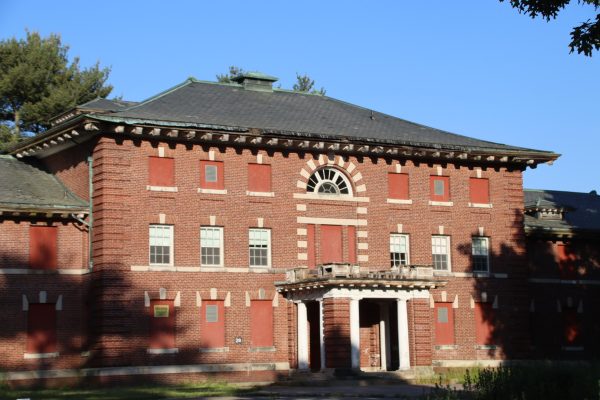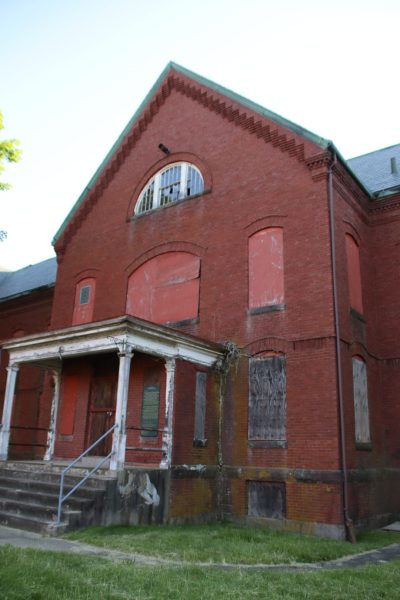Medfield State Hospital is truly a hidden gem. Although many don’t know its history, there is a lot to cover.
“Medfield Insane Asylum,” as it was originally called, opened in 1892 and was originally built to serve about one thousand patients, most of whom were taken in from other overcrowded mental facilities nearby. The campus included 18 ward buildings, a barn, administration buildings, and a chapel, all built under the “cottage design plan.” This design plan was an attempt at making the psych wards a bit more homey and welcoming for the patients. Medfield State was the first hospital in Massachusetts to construct its campus based on this plan. The campus was based on late Victorian-style architecture and is still a beautiful site to this day. The goal of this new facility was to be self-sufficient and prioritize patient success.

It was a rocky start for the hospital under the administration of Edward French. In the first few years of operation, the hospital had a higher death rate than the town of Medfield. In the year 1913, the average life expectancy of a Medfield patient was fifty-five years old. The hospital was forced to build its cemetery due to the overwhelming amount of deaths during the influenza epidemic. Many claimed that the patients were treated like inmates, and there were multiple incidents still remembered to this day. Approaching the mid-nineteen hundreds led to a successful time for the hospital. In 1938, insulin electric shock therapy was used for the first time at Medfield and had some successful results. The rapidly improving medical technologies allowed patient treatment to expand and lead to more and more discharges. The hospital also adopted the “Strep System,” used by Dr. Harold Lee as a method to increase the self-reliance of patients day by day. Dr. Harold Lee was credited for increasing successful patient recoveries and discharges with this method which was unlike anything previous.

As we now know, the treatment of the mentally ill in the eighteen and nineteen hundreds was far from ethical. According to many medical professionals and historians, the American History of Medicine can be divided into reform eras of innovations and treatments used at the time. The National Library of Medicine describes the three stages of twentieth-century medicine as “The Mental Hygiene Movement”, “Community Mental Health Movement and Deinstitutionalization”, and “The Community Support Reform Era.” The mental hygiene movement rested on the idea that mental illness could be treated through science and acute care; this marked the transition away from what was described as “moral medicine” of the early 1800s. The community mental health movement and deinstitutionalization aimed for a type of care with a setting of a small community rather than large and overcrowded prison-like institutions. The community support reform era, similar to the system today, the idea behind this era is not just to cure patients but to improve the standard of living through rehab, in and outpatient care, therapy, etc. There were also many trailblazers of mental illness, medicine, and psychology at this time such as Dorothea Dix and Sigmund Freud. Dorothea Dix was an advocate for the mentally ill and was a leader of the asylum reform who helped start the creation of many new institutions in the US and Europe. She was inspired to help the mentally ill after working at East Cambridge Prison and witnessing the inhumane treatment of prisoners. After these experiences, she investigated facilities all over New England presented her documentation to MA legislatures, and demanded action. As a result, the state set money aside to expand and improve the state hospital of Worcester. Sigmund Freud, known as the father of psychoanalysis, was an influential doctor of the early nineteen hundreds who investigated the relationship between dreams and one’s psychological behavior. With an interest in using his various theories to treat people with disorders, he developed clinical treatment where he attempted to solve conflicts that resided in the unconscious of his patients. His theory was that solving problems in one’s unconscious would allow harmony with all the brain’s components. His ideas inspired many treatments and methods of psych treatment in the nineteen hundreds.

In 2003, the hospital closed after many complaints and safety issues. Many Medfield residents had fears and concerns about living near the so-called “criminally insane”. The hospital itself had deteriorated over time and safety risks with asbestos and lead paint were popping up everywhere. Even with state-issued funding, they ultimately decided it would be best to shut the hospital down for good. The remaining patients were transferred to Westboro State Hospital where they would continue to receive medical care. Although the patients and employees left the hospital for good, the suspicions of ill-conduct and the tainted reputation of the hospital remain. Due to the rumored unethical treatments like lobotomies and electroshock therapies, and the mysterious deaths that occurred, many individuals had made up their minds about the hospital.

Since 1892, the hospital has changed a lot, today it is a location where many people walk their dogs and go on bike rides. The town of Medfield has decided that they will preserve the historical buildings, and use some land for apartments and other land to create a cultural arts facility that will host concerts, classes, and community events. This will be called the Bellforge Art Center.
If this article interests you, check out the others linked below!


































